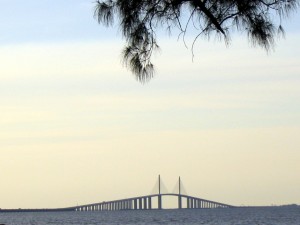Yesterday my wife, her parents, and I visited her sister in Bradenton. It was a nice afternoon – except for the Gator’s game – that was a pretty hard loss to the Seminoles. Afterward, we started home to my in-law’s place in Tampa.
The trip home required a transit across the Sunshine Skyway Bridge. Each time I cross the Skyway, especially at night, I find my mind wandering all over the place.
This city is rich in history and culture. Stories of Fort Brooke and the early days come to mind. I think of the Rough Riders and Teddy Roosevelt massing near the shipyards preparing for their voyage to Cuba during the Spanish American War.
When looking out on the dark waters of Tampa Bay, the birth of scheduled airline flying comes to mind. It was here Tony Jannus piloted the first commercial airline flight between St. Petersburg and Tampa, flying a bi-wing seaplane for the St. Petersburg Tampa Airboat Line. The inaugural flight took place on January 1, 1914.
In World War II, MacDill Field played an important role in training Army Air Corps pilots for the war effort. MacDill served as an advanced training base for the B-26 Marauder, which was one of the most advanced and difficult airplanes to fly at the time.
Several Marauders crashed on land and 13 ditched into Tampa Bay during a 14 month period shortly after the war began. This created the saying, “One a day, in Tampa Bay” among the locals and military pilots alike.
Many pilots believed the Marauder was incapable of flying on one engine. The true problem with the airplane was that it had powerful engines coupled with a small wing area and vertical fin and rudder surfaces. It required precise handling to fly the airplane on one engine. After Jimmy Doolittle and a few other experienced aviators proved the airplane, B-26s stopped dropping into the bay.
From the top of the bridge, I can see where Tampa International Airport brightens the night sky. It was at TPA I cut my teeth as an instrument pilot. I think back to all the times I landed on 36L with fog so thick I almost didn’t make it in. But I always did. Never once did I have to call up the company to tell them I had to divert somewhere else. I am glad those days flying Part 135 are behind me.
As we start down from the top of the span, I think about the bridge itself. The original bridge linked St. Petersburg and the Bradenton area in 1954. Later, state engineers added another span to the first.
These two spans served the State well, but with tragedy. By media and official estimates, some 130 people chose to jump from the bridge to end their lives.
Additionally, the Coast Guard lost 23 men when their ship, the USCGC Blackthorne collided head on with a cruise ship, the Capricorn. This accident happened on January 28, 1980.
A very short time later on May 5, 1980, I remember waking to the excited voice of Captain Al Ford, the Tampa area traffic announcer for WDAE 1250 a.m. radio. At 7:33 on a very stormy morning, a freighter, the Summit Venture, collided with the bridge while trying to navigate in hard rain.
In the fashion of the worst Hollywood disaster movies, the western span of the bridge collapsed. In the poor visibility of the driving rain, a Greyhound bus and six cars plunged 150 feet into the bay. Between the bus and the cars, 35 died.
After the state completed their investigations, they designed and built a completely new bridge just east of where the old bridge once stood. Workers tore down the old structure, but state officials were wise enough to leave the old roadways in place. They now serve as fishing piers. Each year since, I have been meaning to catch some snook off the fishing piers.
Maybe this year.
-30-
© 2010 J. Clark

